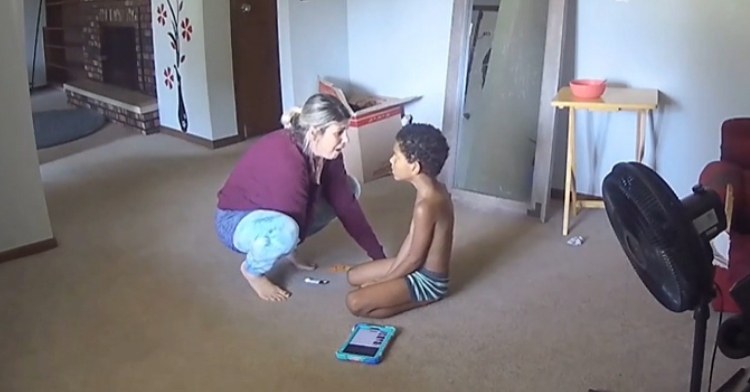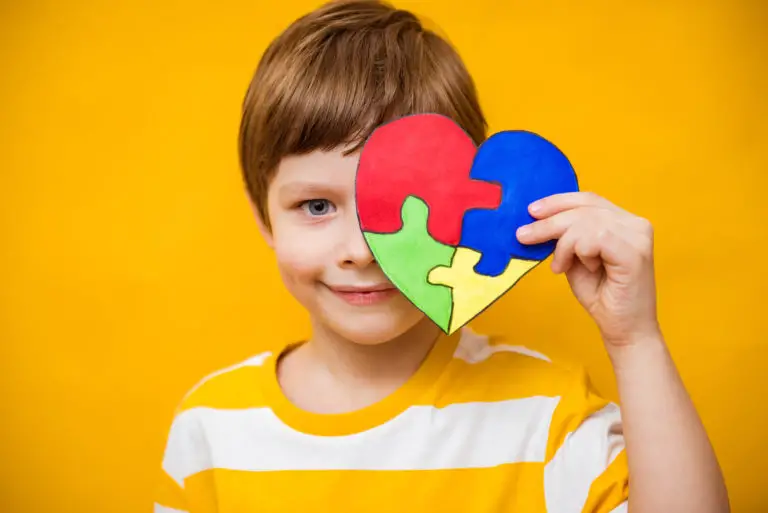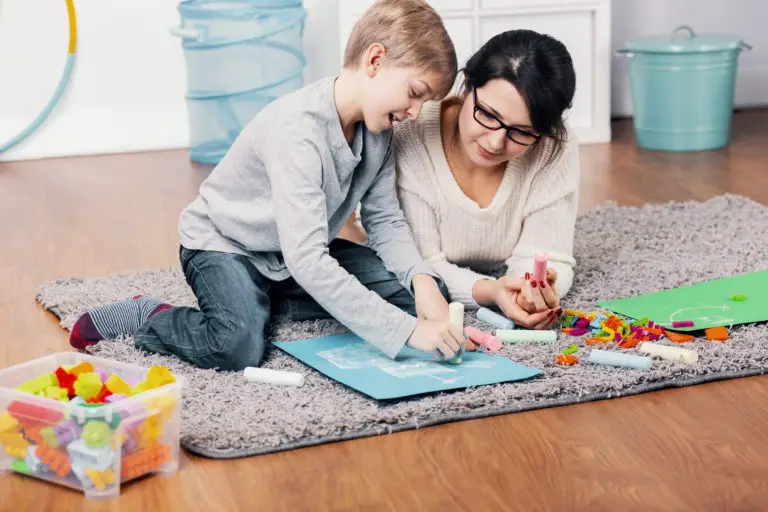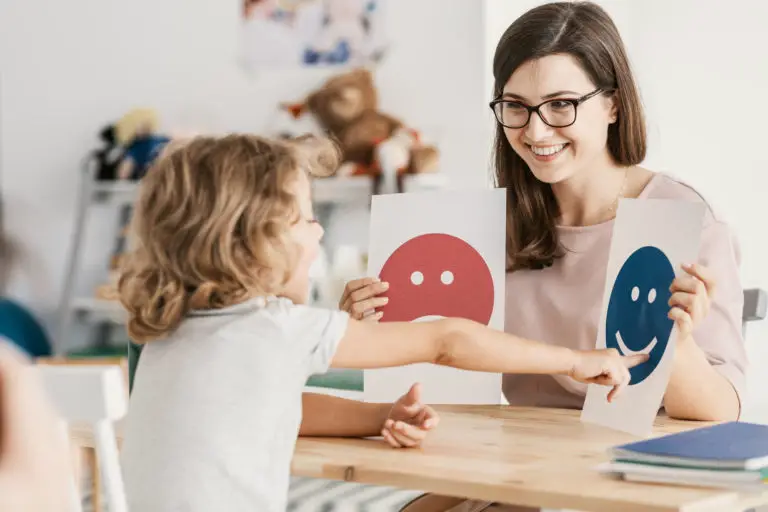Every day, Christy Rawls warmly greets her son, who happens to be on the autism spectrum and has difficulty with verbal communication. Traditionally, her son has never responded with a “good morning” in return due to his non-verbal tendencies. However, a recent heartwarming incident changed this routine, and it was captured by their home security camera.
In a heart-melting turn of events, after Christy greeted her son with a “good morning” one day, her 7-year-old son, Kai, astonishingly replied with a cheerful “good morning” of his own. The shock and joy on Christy’s face were palpable, as her mouth fell open, and she instinctively placed a hand over her heart. This moment of connection between mother and son was so powerful that Kai even repeated the phrase a second time, leaving Christy in tears of happiness.

Following this magical exchange, Kai displayed his happiness by skipping away, mirroring his mother’s overjoyed emotions. This unforgettable moment is bound to remain etched in their hearts forever.
The video capturing Kai’s first “good morning” to his mother is a heartwarming moment to the progress he has made in his communication journey, bringing tears of joy and happiness to anyone who witnesses it.
Defining the Range of Autism Spectrum Disorder
Autism Spectrum Disorder (ASD) is a complex neurodevelopmental condition that affects the way individuals perceive and interact with the world around them. It’s called a “spectrum” because it encompasses a wide range of abilities and challenges. In simpler terms, think of it like a rainbow where each color represents a unique set of characteristics and experiences.
ASD is quite common, with about 1 in 54 children in the United States being diagnosed with it. This means you likely know someone, or will in the future, who is on the autism spectrum.
One of the most notable challenges for autistic individuals is communication. Imagine trying to express your thoughts and feelings, but the words and gestures you use don’t always match what you intend. This can be frustrating and isolating. Some may use non-verbal forms of communication, like gestures or pictures, to bridge this gap.
Additionally, sensory sensitivities can be a part of ASD. Imagine being hypersensitive to everyday sights, sounds, or textures. What seems normal to others can be overwhelming or uncomfortable for someone with ASD.
In essence, understanding autism means recognizing that it’s a diverse spectrum of experiences, and by promoting acceptance and support, we can help individuals with ASD thrive and reach their full potential.
Autism: Signs and Symptoms
Autism Spectrum Disorder (ASD) is a condition that emerges in early childhood, typically before age three. It impacts a child’s ability to communicate, interact socially, and behave in certain ways. Although each individual with autism is unique, there are common signs and symptoms to be aware of:
- Delayed or absence of speech: Children with ASD may develop language skills later than their peers or may not speak at all.
- Limited eye contact: They often have difficulty making and maintaining eye contact during interactions.
- Difficulty with social cues: Understanding emotions, social norms, and nonverbal cues can be challenging for individuals with ASD.
- Repetitive behaviors or interests: Many individuals with autism engage in repetitive actions or have intense, specific interests.
- Sensory sensitivity: Some may be overly sensitive or under-sensitive to sensory stimuli, such as touch, sound, or light.
It’s crucial to seek early diagnosis and intervention if you suspect your child has ASD or developmental delays. Consulting with a healthcare professional will enable accurate assessment and the provision of appropriate support, greatly improving the child’s prospects for a fulfilling life.
Supporting Children with Autism
Supporting children with autism requires a structured approach that prioritizes their comfort and development. First, maintaining a consistent daily routine is crucial. This predictability helps create a safe and reassuring environment.
- Effective communication is also vital. Keep instructions and interactions clear and concise. Visual aids and social stories can be invaluable tools for conveying information.
- Autistic individuals often have unique sensory needs. Offer sensory regulation opportunities, like providing sensory objects or adapting the environment to be sensory-friendly.
- Recognize and celebrate even the smallest achievements, as this positively reinforces their progress and self-esteem.
- Lastly, professional support is invaluable. Seek guidance from therapists, educators, and support groups that specialize in autism. They can provide tailored strategies and expertise to help your loved one thrive and navigate the challenges associated with autism.
Remember, patience and understanding are key when supporting children with autism.
The Role of Positive Reinforcement in their Development
Positive reinforcement plays a crucial role in supporting the development of individuals with autism. Imagine it as a tool that helps shape behavior in a way that promotes learning and social growth.
Positive reinforcement involves acknowledging and rewarding desired behaviors. Just like when you praise a child for finishing their homework or a colleague for a job well done, individuals with autism respond positively to praise, encouragement, and rewards when they exhibit desirable behaviors or achieve milestones.
This method helps individuals with autism learn new skills, enhance communication, and build positive relationships. It motivates them to repeat behaviors that lead to favorable outcomes, making it easier for them to navigate their world and interact with others.
Understanding and utilizing positive reinforcement is like finding the right keys to unlock a person’s potential, helping them build essential skills, connect with others, and lead fulfilling lives despite the unique challenges posed by autism.
Celebrating Small and Big Milestones for Children with Autism
Autism, a neurological condition, affects how a person communicates, socializes, and perceives the world. It’s essential to comprehend the significance of celebrating both small and big milestones in the lives of children with autism.
For children on the autism spectrum, achieving developmental milestones can be more challenging than for their neurotypical peers. Simple tasks like making eye contact, speaking their first words, or forming friendships may require extra effort and time. Celebrating these achievements, no matter how minor they may seem to others, plays a crucial role in their overall development.
Firstly, acknowledging and praising small victories boosts a child’s self-esteem. This positive reinforcement motivates them to keep trying, promoting further progress. Additionally, celebrating these moments creates a supportive environment, fostering a sense of acceptance and belonging.
Big milestones, like graduating from therapy or successfully navigating a social situation, signify significant progress. They remind everyone involved of the child’s potential and resilience. Celebrations also serve as opportunities for families and communities to come together, offering emotional support and strengthening connections.
Celebrating small and big milestones for children with autism is not just about recognizing their accomplishments; it’s about building their confidence, fostering inclusion, and reinforcing the belief that they can achieve their goals, no matter how unique their journey may be.
A Glowing Moment of Connection
The video of Kai speaking directly to his mom for the first time is not only a joyous celebration of a major milestone in their lives, but it also serves as an inspiration for parents and caregivers of children with autism. It reminds us of the power of love, perseverance, and the untapped potential within each individual. May Kai’s breakthrough ignite hope for many others.
@4aries14 *** 🥹🥹🥹*** Autism nonverbal mother happiness overload moment!!! 💙💙🧩🧩💙💙 I had an emotional moment this morning with my Kai. He’s almost 7 & is considered non verbal. Well, this morning I did my usual “Good morning” & he finally said it back to me, TWICE, & with full emotion. I say it once then you hear him tell me it back 2 times. 🙌🏽🙌🏽 Edit:: I normally try not to react that way bc we know he can do it, so I try not to over praise BUT I’ve been saying this for 6 yrs & always say to him….”One day you’re going to tell me it back homie” 😌 (I threw on my sweats/sweatshirt over my long pjs to take Kira to the bus right before this 🥴😆) #autism #autismawareness #nonverbal #autismmom #autistic #proudmoment #tearjerker #amazing #love #family #autismlove #autismsupport #sensory #neurodivergent #motherlove
♬ original sound – Cristy Rawls
Source:
What is Autism Spectrum Disorder?
Signs and Symptoms of Autism Spectrum Disorder
Interacting with a Child Who Has Autism Spectrum Disorder

This Site Was Inspired By An Interest in Protecting the Environment:
We had the privilege and joy of learning from Dr. Charlie Stine who instilled a love for the natural world through incredible field trips with the Johns Hopkins Odyssey Certificate program in Environmental Studies. At the time, the program was endorsed by the Maryland Department of Natural Resources. Sadly, after Dr. Stine retired, the program was phased out. We hope that we honor his legacy by shining a bright light on environmental issues and sharing good news about the success of various conservation programs when possible.




